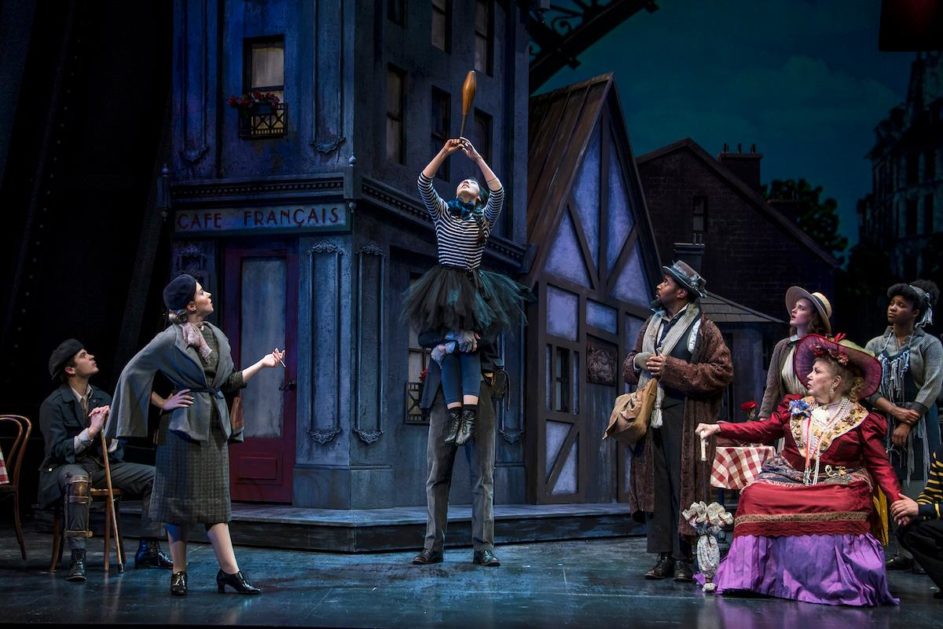It’s very tempting to look for parallels between today’s climate of self-enrichment attitudes and the greed vs. civic consciousness that is at the center of French playwright Jean Giraudoux’s 1945 poetic fantasy “The Madwoman of Chaillot,” currently on stage at Clarence Brown Theatre.
There are enough greedy people on display in today’s politics and news cycles that no one needs to see a play to get the idea. But there are seven good reasons otherwise to go see “Madwoman.”
Reason One: Carol Mayo Jenkins. At 80, Jenkins is the unofficial Dame of Clarence Brown. Even when she is doing nothing but sitting quietly in a chair on the right of the stage while the activity goes on elsewhere, she lights up the whole place.
Reason Two: Carol Mayo Jenkins. As Aurelie, the Madwoman of Chaillot, Jenkins adds dignity and reason to otherwise unsavory activities. “Madwoman” is high-style satire that one doesn’t have to think too much about to get the gist of the idea that, left to their own devices, greedy people have little regard for anyone but themselves and are more than willing to crush anyone who gets in their way. At the same time, as Aurelie knows well and uses to her advantage, greedy people can also be gullible and fall into the same kinds of traps they gleefully set for other people.

Terry Weber as The Chairman of the Board, Collin Andrews as The Stock-Broker, David Brian Alley as The Prospector and Brian Gligor as The Baron
Reason Three: Terry Weber as The Chairman of the Board, the chief greed-monger; Brian Gligor as The Baron, proof that there is no honor among thieves; Collin Andrews as The Stock-Broker, who arranges the Chairman’s deals and would sell the same stick to everyone in the same crowd; and David Brian Alley as The Prospector, who doesn’t like one bit that the city of Paris puts up tourist sites and places for children to play in all the best places where one could get rich by strip-mining.
Reason Four: Christopher Pickart’s set design. The Paris neighborhood of Chaillot that occupies the stage in Act I is located under a big bridge, the framework of which majestically dominates the stage and gives a sense of intimacy to the little café and street underneath the ornate cast-iron framework and massive support columns that disappear into the rafters. Pickart creates a sense of a grand Paris, with the feel of a small, lovely neighborhood. In Act II, his below-street apartment offers views of the activity up on the street, complete with Collin Hall’s projection images of passersby moving in each direction.
Reason Five: Erin Reed’s costume design. Reed’s lavish dressing of Aurelie both gives her a sense of class and endows her with power. She makes Tarah Flanagan’s Constance, the Madwoman of Passy, even more diminutive with an oversized hat and enough frills for a pile of whipped cream on a pecan pie. Katie Cunningham’s Josephine, the Madwoman of la Concorde, has a sense of business authority endowed by Reed’s executive but ladylike business suit.
Reason Six: Director Paul Barnes. Despite dealing with enough dialogue to fill the scripts of two plays, much of it dished out in third and fourth gears, Barnes manages his characters’ speeches in such a way that none of the flood of words drowns any of the scenes. But it does mean that there cannot be any dozing off in either act. Switching to English from the original French loses some of the music in the language, so his cast’s delivery of the lines becomes even more critical.
Reason Seven: The moral triumph of good over greed. Sometimes in life, the corrupt seem to succeed. There’s even more than a little admiration for rich people, regardless of how they got their wealth. We tend to let them get away with things we don’t allow ordinary people to do. The lesson Aurelie teaches is that it doesn’t have to be that way.

